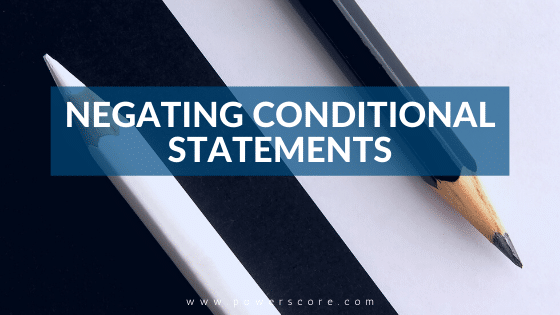Most Logical Reasoning questions with conditional reasoning won’t require you to negate the conditional relationships in them. You will certainly need to know what the contrapositive is, and—if there are multiple conditional relationships—you need to know how to form a conclusion by combining them into a chain (aka the “law of syllogism”). Occasionally, in Justify questions, you will need to establish a logical link between the premises and the conclusion. And in Flaw questions, you will need to know how to describe in abstract terms the most common logical fallacies involving conditional reasoning.
Logical Opposites
Occasionally, however, you will need to know the logical opposite of conditional statements. This occurs most frequently in CANNOT be true questions with conditional reasoning, whereby the correct answer choice is the one that can be disproven using the information contained in the stimulus. Even more importantly, many Assumption questions have answer choices that themselves contain conditional reasoning. Students often struggle to apply the Assumption Negation Technique in such cases, because its application requires examining the logical opposite of each answer choice (and its effect on the conclusion of the argument). If the statement is quite simple, negating it is relatively simple as well. However, if the answer choice takes a conditional form, things get trickier.
Clearing Misconceptions
- The logical opposite of a conditional statement is not its contrapositive. The contrapositive is identical, not opposite, in meaning to the original statement. If you thought that a logical opposite of a given statement takes the form of a contrapositive, sorry but you don’t understand what a contrapositive is.
- The logical opposite of a conditional statement is not its Mistaken Reversal or Mistaken Negation. These are inferential errors in reasoning, i.e. the fallacy lies in the erroneous assumption that the MR or MN must be true given the original statement. However, just because they are not necessarily true does not mean that they are provably false. If all rainy days are cloudy (R –> C), it surely does not follow that all cloudy days are rainy (that’s a Mistaken Reversal); however, it is possible that all cloudy days are rainy. Just because we cannot prove a statement to be true does not mean that it is false. To assume otherwise is, in and of itself, a deductive error in the use of evidence.
The Opposite of Conditional Statements
It is a statement showing that the sufficient condition can occur in the absence of the necessary condition: i.e. a statement proving that the necessary condition isn’t necessary. So, the logical opposite of “all rainy days are cloudy” is simply “not all rainy days are cloudy” (or “some rainy days are not cloudy”). This shows that R can occur without C being present. Even just one occurrence will weaken the original statement, because it is directly contradicted by it.
Quite often, the logical opposite of a conditional statement is formed using the phrase “even if.” Consider the following example:
Unless you practice, you won’t succeed.
Using the Unless Equation, we can simplify the statement as:
Succeed –> Practice
The logical opposite of the statement would be:
You can succeed even if you don’t practice.
The last statement directly contradicts the original (and its contrapositive). Note that “even if” is not, by itself, an indicator of a sufficient condition. It merely states that the lack of practice does not prevent you from succeeding, not that the lack of practice somehow ensures success.
Practice Makes Perfect
Understanding the idea behind a logical opposite is a crucial, but often overlooked, chapter in Logical Reasoning. With some practice, negating conditional statements should become second nature. The goal is to understand the conceptual framework behind the idea, and then repeatedly apply it. It needs to be at the point where you don’t even think about it. You just do it.


Leave a Reply